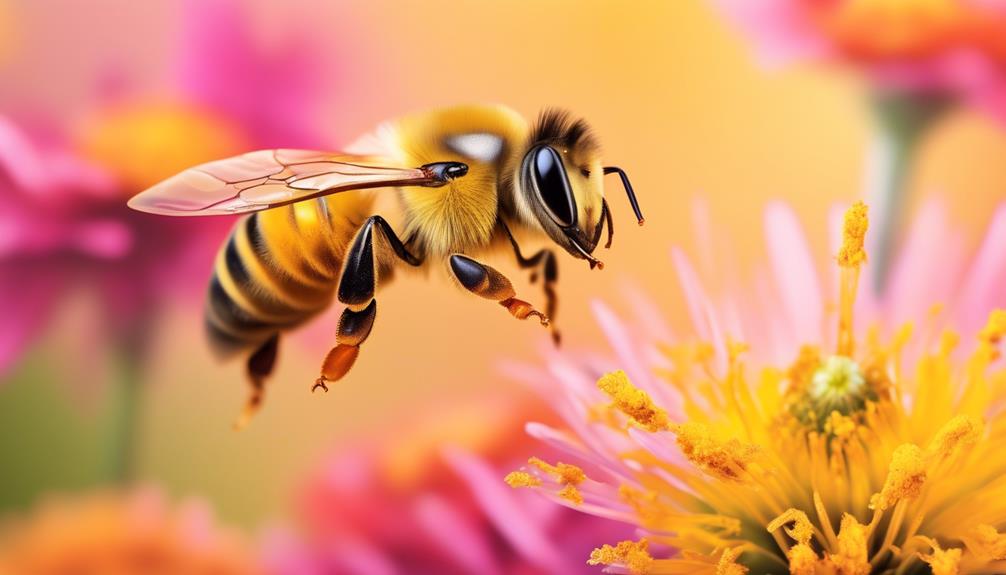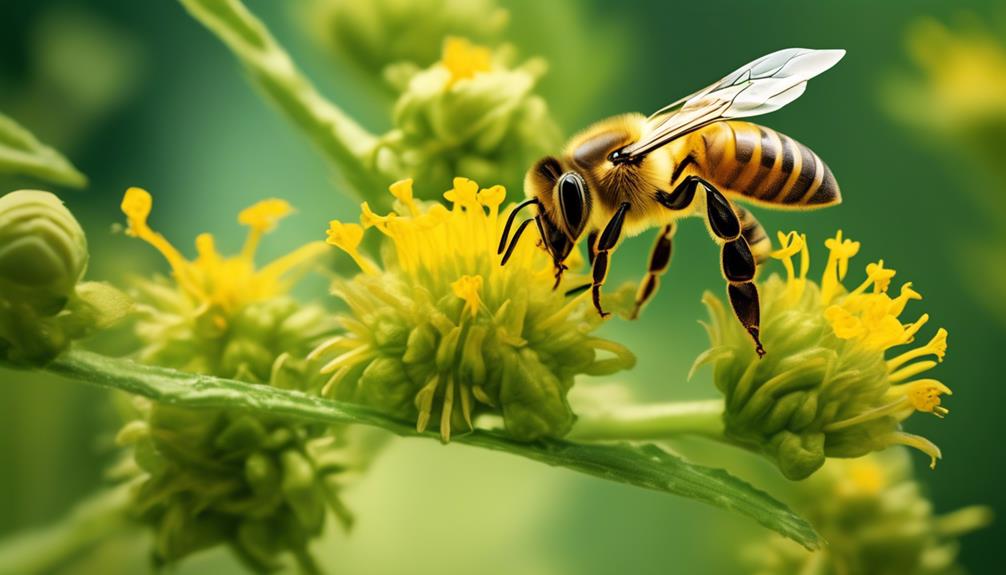Observe the intriguing science behind bees' yellow hue, a color vital for communication, defense, pollination, and environmental impact.

Why Are Bees Yellow?
Imagine a warm, sunny day with flowers in full bloom, and there, amid the vibrant colors, you spot a small, buzzing creature adorned in stripes of black and yellow – a bee.
You've probably wondered about the yellow color, haven't you? Well, it's not merely a design choice by Mother Nature; it serves a crucial purpose. The yellow hue of bees is a fascinating topic, interwoven with aspects of science, communication, defense mechanisms, pollination, and even environmental impact.
As we unravel these factors, you'll discover why bees don their yellow attire, and along the way, you just might gain a new appreciation for these industrious insects.
Key Takeaways
- Bees' yellow color serves as a warning sign to predators and helps in their defense mechanism.
- Yellow is a key visual cue for bees' communication and aids in locating forage sites.
- Bees' yellow color plays a role in pollination by helping them communicate with plants and other bees.
- The yellow color of bees has a positive environmental impact by maintaining biodiversity and supporting the food chain through pollination.
The Science Behind Bees' Color

To unravel the mystery of why bees are yellow, it's essential to dive into the science behind their distinctive coloration. You see, the coloration isn't just a random choice by nature, it's a critical component of their survival strategy.
Scientists have discovered that bees' yellow color primarily serves two purposes – for defense and for communication. The bright yellow is a warning sign to predators that they're not a good meal choice due to their sting. This phenomenon, called aposematism, is used by many animals to deter predators.
Now, let's talk about communication. Bees use their color to signal to other bees. The yellow and black stripes are an effective visual guide for other bees to find flowers and collect pollen. It's an intricate visual language only they understand.
Furthermore, bees' yellow color is a product of their pigmentation and the structure of their exoskeletons. The pigments are derived from their diet and are deposited in the cuticle of their exoskeleton, which, when combined with light reflection, gives them their yellow hue.
Role of Yellow in Bee Communication

Delving further into the role of yellow in bee communication, it's fascinating to note how this seemingly simple color plays a pivotal role in their complex communication system.
Yellow, you see, isn't just an arbitrary hue for these insects. It's a key visual cue that aids in their survival and productivity.
Bees are trichromatic, much like us humans. This means they see three colors: blue, green, and 'bee's yellow', a color combination of yellow and ultraviolet that we can't perceive. This unique color vision allows them to detect flowers' rich nectar sources from a distance. Yellow, being a highly reflective color, stands out against the natural green foliage, enabling bees to locate and return to profitable forage sites.
Moreover, the yellow markings on a bee's body aren't mere decoration. They're a form of aposematic coloration, serving as a warning to predators of their potentially harmful stings. The conspicuousness of yellow thus acts as a defensive strategy, preserving the bee population.
In essence, yellow isn't just part of bees' physical appearance. It's an integral component in their communication, navigation, and defense, underlying the importance of color in the natural world.
Yellow: A Defense Mechanism

Diving into the realm of defense mechanisms in the bee world, you'll find that the yellow coloration isn't just for aesthetics; it's a vital tool that bees employ to ward off potential predators. This is a striking example of aposematism, a biological phenomenon where organisms develop bright colors to signal potential danger to predators.
Predators often associate bright colors with poison or venom, creating a natural deterrent. Bees, with their distinct yellow and black stripes, are no exception. It's not the yellow color itself that deters predators, but their ingrained association of this color with danger.
Moreover, the intensity of yellow in bees also correlates with the amount of venom they can deliver. This is the result of a co-evolutionary process where predators learn to avoid the most venomous species, reinforcing the survival advantage of brighter colors.
How Bees' Color Affects Pollination

Interestingly, the bees' vibrant yellow color not only plays a crucial role in their defense mechanism, but it's also instrumental in their pollination activities. You may not know this, but bees' color aids in their communication with plants. Yes, you read that right. Certain flowers have evolved to become attractive to bees, and bees' color vision is primed to pick up on this specific type of coloration.
Now, let's delve deeper. As a bee approaches a flower, the flower's ultraviolet patterns, invisible to you and me, are highlighted by the bee's yellow hue. This process, known as 'bee vision', amplifies the contrast between the flower's petals and its center, making it easier for the bee to locate the nectar.
Moreover, bees' yellow color also helps them to be more visible to other bees. Through a phenomenon known as 'bee's dance', they communicate the location of nectar sources to their hive mates. Their bright color makes these dances easier to follow, improving the efficiency of the hive's collective foraging efforts.
Environmental Impact of Bees' Yellow Color

Having explored how the bees' yellow color aids in pollination and communication amongst the hive, let's now consider its broader environmental impact.
The yellow pigmentation of bees plays a pivotal role in maintaining the biodiversity of our planet. This is because the yellow color of bees, specifically their yellow and black stripes, serves as a warning signal to potential predators. This aposematic coloration, as it's scientifically known, allows bees to go about their pollination activities with reduced threat, thereby promoting the growth and propagation of diverse plant species.
Your garden's vibrant flowers, the lush forest landscape, and the variety of fruits we enjoy are all directly linked to the bees' yellow hue. Their color not only ensures their survival but also indirectly influences the survival of various plant species. Moreover, by facilitating pollination, bees' yellow color indirectly supports the food chain as many other species rely on these plants for nourishment.
Thus, one could argue that the yellow color of bees has a ripple effect on the entire ecosystem. It's an elegant illustration of how even the smallest details in nature, such as the color of a bee, can have a profound impact on the environment at large.
Frequently Asked Questions
What Other Colors Apart From Yellow Can Be Observed on Bees?
Apart from yellow, you'll often see bees sporting different shades of brown, black, and even green on their bodies. Some species have metallic blue or green tints.
For instance, the Carpenter bee has a vibrant blue-black, metallic sheen. The Green Sweat bee, as its name suggests, has a lovely green hue.
These color variations depend on the bee species and serve various purposes, from camouflage to communication.
How Does the Yellow Color of Bees Affect Their Lifespan?
The yellow color of bees doesn't directly affect their lifespan. It's actually their genetic makeup and environmental factors that determine how long they'll live.
However, the yellow pigmentation serves a crucial role in their survival. It acts as a warning signal to predators, which in turn could indirectly contribute to a bee's lifespan.
Predators recognize the bright color and associate it with danger, so they're less likely to attack.
Are There Any Specific Bee Species That Are Not Yellow?
Yes, there are several bee species that aren't yellow. For instance, you've got the Carpenter bees, which are typically black without any yellow markings.
Then there's the Blue-banded bees that have metallic blue stripes instead of yellow.
And don't forget about the Sweat bees, which can be green, blue, or even red.
How Does the Yellow Color of Bees Affect Their Interaction With Other Insects?
You're probably wondering how a bee's yellow color affects its interactions with other insects.
Well, it's all about warning signals. This bright coloration is called aposematism and is nature's way of saying 'stay back – I'm dangerous'.
Many predators associate bright colors with danger, like venom or poison, leading them to avoid bees.
Is There a Significance of the Yellow Color in Bees' Honey Production Process?
No, there's no direct significance of a bee's yellow color in its honey production process. It's their anatomy, not color, that matters here. They've specialized organs, like the honey stomach and wax glands, to collect nectar and produce honey.
Color, however, plays a role in their communication and defense strategies, but it doesn't influence their honey-making abilities. So, it's safe to say that the bee's yellow hue doesn't affect its honey production.
Conclusion
So, you've uncovered the science behind why bees are yellow. This color serves not only as a crucial communication tool, but also as a defense mechanism against predators.
The yellow hue plays a key role in pollination, fostering a symbiotic relationship with plants.
More than just a simple color, bees' yellow bodies have a profound environmental impact, emphasizing their indispensability in our fragile ecosystem.
The world of bees is indeed a fascinating one, colored by more than meets the eye.


